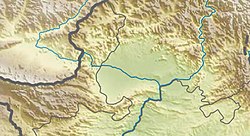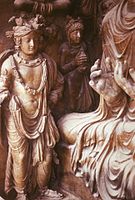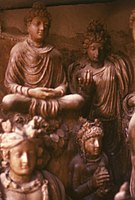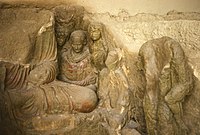Tapa Shotor
| Coordinates | 34°21′58″N 70°28′08″E / 34.366041°N 70.468981°E |
|---|---|
| Type | Buddhist monastery |
| History | |
| Founded | 1st century BCE |
| Abandoned | 9th century CE |


Tapa Shotor, also Tape Shotor or Tapa-e-shotor ("Camel Hill"),
The site of Tapa Shotor was destroyed by arson and looted in 1992.[1]
Stylistic analysis
In view of the style of the objects found at Tapa Shotor, particularly the clay figures, Allchin suggests that either Bactrian artists came and worked for Buddhist monasteries, or that local artists had become "fully conversant" in Hellenistic art.[7] This opinion was confirmed by the archaeologist who excavated the site Tarzi: "in the light of the latest discoveries there is no longer any doubt about the prolongation of the Graeco-Bactrian artistic past".[8] According to Tarzi, Tapa Shotor, with clay sculptures dated to the 2nd century CE, represents the "missing link" between the Hellenistic art of Bactria, and the later stucco sculptures found at Hadda, usually dated to the 3rd-4th century CE.[1] The sculptures of Tapa Shortor are also contemporary with many of the early Buddhist sculptures found in Gandhara.[1]
Traditionally, the influx of artists conversant in Hellenistic art has been attributed to the migration of the Greek populations from the
Chronology
According to archaeologist
- Tapa Shotor I: Indo-Scythian king Azes II(35-12 BCE)
- Tapa Shotor II: Vihara, and niches V1, V2 and V3
- Tapa Shotor III: (187-191 CE)
- Tapa Shotor IV: Vasudeva I (191-225 CE)
- Tapa Shotor V: Last Kushans (225-350 CE)
- Tapa Shotor VI: Kidarites (350-450 CE)
- Tapa Shotor VII: 5th century
- Tapa Shotor VIII: 6th century. Corresponds to the 1st period of Tape Tope Kalan.
- hiatus (6th-8th century)
- Tapa Shotor IX: mid 8th century-9th century. Destruction by fire
Excavation
The monastery was excavated by an all-Afghan archaeological team. It yielded numerous sculptures in an archaeologically intact environment, providing great insights on the art of the region. A stupa was excavated in the main courtyard.[11]
A coin of the Indo-Greek king Menander was found in the ruins, but the abundance of finds of Kushan coinage suggest a main 4th century CE date for the site.[11]
Tapa Shortor had some beautiful statuary in Hellenistic style, particularly one seated Buddha attended by

Many of the statues are three-dimensional representations in-the-round, a rare instance in the area of Hadda, which related the style of Tapa Shotor to the Hellenistic art of Bactria, and to the Buddhist caves of Xinjiang such as the Mogao Caves, probably directly inspired by these.[17]
Various niches display scenes of the Buddha surrounded by attendants (especially niches V1, V2, V3). Niche XIII, or "Aquatic niche", also demonstrates sculpture in the round, and depicts Naga Kalika predicting the success of the
-
Map of Hadda, by Charles Masson in 1841. Tapa Shotor was the "Large Mound with a hollow".[21]
-
Attendants to the Buddha, Tapa Shotor (Niche V1)
-
Buddha attendants, Tapa Shotor (Niche V1)
-
Seated Buddha with "Vajrapani-Alexander" attendant. Tapa Shotor (Niche V3).[24]
-
Head of "Vajrapani-Alexander", Tapa (Niche V3).[25]
-
Buddha attendants, Tapa Shotor
-
Small decorated stupas in Tapa Shotor.[26]
-
Site of Tapa Shotor, with a protective roof.[26]
External links
- Description and plan of Tapa Shotor (French)
- The famous Buddha with Herakles-Vajrapani and Tyche can be seen in Vanleene, Alexandra. "The Geography of Gandhara Art" (PDF): 150.
{{cite journal}}: Cite journal requires|journal=(help)
References
- ^ a b c d Tarzi, Zémaryalai. "Le site ruiné de Hadda": 62 ff.
{{cite journal}}: Cite journal requires|journal=(help) - ^ "Tepe Shotor Tableau. Hadda, Nangarhar Province. ACKU Images System". ackuimages.photoshelter.com.
- ISBN 978-1-58839-224-4.
- ^ Boardman, George. The Greeks in Asia. pp. Greeks and their arts in India.
- ^ Vanleene, Alexandra. "The Geography of Gandhara Art" (PDF): 143.
{{cite journal}}: Cite journal requires|journal=(help) - ^ Vanleene, Alexandra. "The Geography of Gandhara Art" (PDF): 158.
{{cite journal}}: Cite journal requires|journal=(help) - ^ ISBN 9788186030486.
- JSTOR 29757655.
- ^ a b Tarzi, Zémaryalai. "Le site ruiné de Hadda": 63.
{{cite journal}}: Cite journal requires|journal=(help) - ^ a b c d Vanleene, Alexandra. "Tapa-e Shotor". Hadda Archeo Data Base. ArcheoDB, 2021.
- ^ a b Kuwayama, Shoshin (1988). "Tapa Shotor and Lalma: Aspects of stupa courts at Hadda" (PDF). Annali dell'Università degli studi di Napoli "L'Orientale".
- ISBN 978-1-58839-224-4.
- ^ Vanleene, Alexandra. "The Geography of Gandhara Art" (PDF): 148-149.
{{cite journal}}: Cite journal requires|journal=(help) - ISBN 978-0-691-03680-9.
- ^ Vanleene, Alexandra. "The Geography of Gandhara Art" (PDF): 150.
{{cite journal}}: Cite journal requires|journal=(help) - ISBN 978-0-691-03680-9.
- ^ Vanleene, Alexandra. "The Geography of Gandhara Art" (PDF): 152-153.
{{cite journal}}: Cite journal requires|journal=(help) - JSTOR 29757655.
- ^ Vanleene, Alexandra. "The Geography of Gandhara Art" (PDF): 152-153.
{{cite journal}}: Cite journal requires|journal=(help) - ^ Vanleene, Alexandra. "The Geography of Gandhara Art" (PDF): 152-153.
{{cite journal}}: Cite journal requires|journal=(help) - ^ Errington, Elizabeth. "Masson archive Vol. 2 (1).pdf": 36.
{{cite journal}}: Cite journal requires|journal=(help) - JSTOR 24240815.
- ^ Vanleene, Alexandra. "The Geography of Gandhara Art" (PDF): 154.
{{cite journal}}: Cite journal requires|journal=(help) - ^ Vanleene, Alexandra. "The Geography of Gandhara Art" (PDF): 150.
{{cite journal}}: Cite journal requires|journal=(help) - ^ Vanleene, Alexandra. "The Geography of Gandhara Art" (PDF): 150.
{{cite journal}}: Cite journal requires|journal=(help) - ^ a b Tarzi, Zémaryalai. "Le site ruiné de Hadda".
{{cite journal}}: Cite journal requires|journal=(help)




![Map of Hadda, by Charles Masson in 1841. Tapa Shotor was the "Large Mound with a hollow".[21]](http://upload.wikimedia.org/wikipedia/commons/thumb/6/6e/Map_of_Hadda%2C_Charles_Masson_1841.jpg/200px-Map_of_Hadda%2C_Charles_Masson_1841.jpg)
![Painting of the lunette of an underground meditation chamber.[22] Tapa Shotor, period VI (350-450 CE).[23]](http://upload.wikimedia.org/wikipedia/commons/thumb/6/66/Tapa_Shotor_lunette.jpg/200px-Tapa_Shotor_lunette.jpg)


![Seated Buddha with "Vajrapani-Alexander" attendant. Tapa Shotor (Niche V3).[24]](http://upload.wikimedia.org/wikipedia/commons/thumb/a/aa/Tapa_Shotor%2C_seated_Buddha%2C_Niche_V3.jpg/150px-Tapa_Shotor%2C_seated_Buddha%2C_Niche_V3.jpg)
![Head of "Vajrapani-Alexander", Tapa (Niche V3).[25]](http://upload.wikimedia.org/wikipedia/commons/thumb/9/91/Vajrapani-Alexander%2C_Tapa_Shotor.jpg/137px-Vajrapani-Alexander%2C_Tapa_Shotor.jpg)

![Small decorated stupas in Tapa Shotor.[26]](http://upload.wikimedia.org/wikipedia/commons/thumb/0/05/Rze%C5%BAby_z_buddyjskiej_stupy_-_Hadda_-_001553s.jpg/200px-Rze%C5%BAby_z_buddyjskiej_stupy_-_Hadda_-_001553s.jpg)
![Site of Tapa Shotor, with a protective roof.[26]](http://upload.wikimedia.org/wikipedia/commons/thumb/6/6b/Wykopaliska_buddyjskie_-_Hadda_-_001545s.jpg/200px-Wykopaliska_buddyjskie_-_Hadda_-_001545s.jpg)